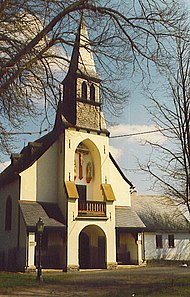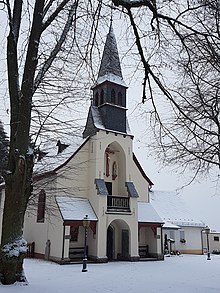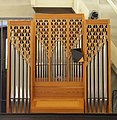Marienkapelle (Beselich)
| Mary help | |
|---|---|
| Denomination : | Roman Catholic |
| Patronage : | Seven Sorrows of Mary |
| Consecration date : | 08.09 1767 |
| Rank: | Pilgrimage chapel |
| Parish : | St. John Nepomuk Hadamar |
| Address: | Schlossgasse 11, 65589 Hadamar |
Coordinates: 50 ° 27 '2.7 " N , 8 ° 8" 31.4 " E
Since its construction and inauguration in September 1767, the Maria Hilf chapel has been a Catholic Marien pilgrimage chapel on the Beselicher Kopf in the Hessian municipality of Beselich in the Limburg-Weilburg district of the same name . It is an important place of pilgrimage in the local region and is firmly anchored in popular piety . It was located since the fall of 1802 to the end of 2019 owned by the Catholic parish of St. Giles Beselich-Obertiefenbach in the diocese Limburg . Since the beginning of 2020 she has been part of the parish of St. Johannes Nepomuk Hadamar.
The seven chapels, which are reminiscent of the Seven Sorrows of Mary , on Betweg in the forest of Obertiefenbach to the chapel, belong to the ensemble of the pilgrimage chapel after their completion in 1877.
Geographical location
At 296 m, the Beselicher Kopf is the highest point in the municipality of Beselich on the edge of the Limburg Basin . It is located in a scenic location in the center of this community, which owes its name to when it was founded on December 30, 1970 through the merger of four formerly independent communities. The chapel can be reached via the two streets between the Beselich districts of Obertiefenbach and Schupbach as well as Niedertiefenbach and Schupbach. Next to the pilgrimage chapel is the monumental ruins of the Beselich monastery with the former monastery courtyard used for agriculture.
Buildings and equipment
The chapel consists of a nave and a slated church tower above the entrance, in which there are three bells. A large outer pulpit for sermons is integrated into the tower . On both sides of the main entrance there are two niches with slated canopies. In the choir there is the marble altar on which the Virgin Mary is depicted with the baby Jesus in the middle. The two altar windows show the birth of Christ and Jesus in the temple of Jerusalem. The figures of the fourteen helpers in need are attached to both fronts of the choir . Various statues, a representation of the Trinity of God as well as Jesus and Mary with their worldly ancestors can be seen on the outer walls. In addition, there is an overwhelming number of votive and thank you tablets, mostly made of marble . The pipe organ , which is located on the gallery that can be reached via a wooden staircase , sounds during solemn services. Inside the pilgrimage chapel there is space for around 100 people on the pews. The paved forecourt, which is surrounded by a small park, is used for the closing church services of the pilgrimages. Several hundred believers usually gather here.
A saddle-roofed house is built directly onto the chapel and serves as a sexton's apartment.
The interior of the chapel was renovated in 2002 through donations from the population and with the support of the Limburg diocese, and most of it was restored to its original state. The church roof was re-covered in spring 2013. The entire exterior painting in spring 2017 gave the chapel its full splendor in the anniversary year.
organ
The organ on the gallery today replaced the 300-year-old baroque organ that was put into service on May 15, 1994. The pipe organ (II / P / 7) of the Schmid organ builder , which was procured through the instrument trade in Ladach in Wuppertal and manufactured in 1990, was intoned by the same organ builder and inaugurated on May 11, 2014. It is equipped with interchangeable loops and has seven registers , which are distributed over two manuals and pedal . The disposition is as follows:
|
|
|
||||||||||||||||||||||||||||||||||||||||||||
- Pairing : I / P, II / P
history
The Chapel - benediziert in honor of the Fourteen Holy Helpers - owes its origin to the initiative of a Franciscan - hermits , the Friar Leonhard (real name: Georg Niedermeier roads). He was born in 1709 and after an extensive wandering life he built a hermit's house near the former Beselich monastery in 1763. In the following year the foundation stone of the chapel is laid by Pastor Johannes Schuld from Obertiefenbach. The building site was made available by the owners, the Prince of Salm and the Count of Westerloo . The construction of the chapel is financed by donating the building material from the community of Obertiefenbach and by some generous donations. With the active support of the population from Obertiefenbach, the chapel was built and consecrated on September 8, 1767 by Obertiefenbach Pastor Löhr at Niederstraßen's request in the name of Maria Hilf and in honor of the Fourteen Holy Helpers.
In 1768 the chapel of Rome was pardoned with a complete indulgence for the feast of the birth of the Virgin Mary, which was moved to the Assumption of Mary in 1786. In 1769, Beselich received a station indulgence from the Provincial of the Hermit Province. In the Koblenz hermit chapter, the Franciscan Georg Niederstrasse was given the religious name Leonhard and he was solemnly installed as a hermit in Beselich in 1770 by representatives of this chapter. Georg Niederstraßen died on December 23, 1787 in Beselich; his tombstone is on the outside of the chapel.
In the period that followed, the Marienkapelle Beselich was not only a pilgrimage chapel, but also a place of refuge for a number of displaced religious who had to leave their places of activity due to political changes and secularization . The processions to the pilgrimage chapel, which take place on various Christian holidays, initially take place from Obertiefenbach. Later, they are carried out by many different Catholic parishes in the area, sometimes with a final sermon from the outer pulpit of the chapel, and are maintained to this day. Pilgrimages are forbidden from 1815 to 1848. Only the processions on St. Mark's Day , the Prayer Days and the Corpus Christi procession within the district are tolerated. The Bishop of Limburg Peter Joseph Blum studied at the time of the Kulturkampf shortly before he fled into exile in 1876 the chapel Beselich and kneels in front of the picture of grace, to pray. When leaving the Marienkapelle, his farewell words are "Receive me Beselich!"
In 1984 the “Friends for the Preservation of the Beselich Chapel” was founded, which set itself the task of maintaining the chapel and the Betweg with its seven chapels in close cooperation with the Catholic parish of Obertiefenbach.
The big anniversary celebration for the 250th anniversary of the chapel took place in September 2017 with the participation of Limburg Bishop Georg Bätzing and more than a thousand visitors.
Todays use
Today the Marienkapelle is the destination of many pilgrims and prayers every day . In the months of May to October, a place every Friday at 18:30 Eucharist and on Sundays at 17:00 a Marian devotion with preaching and sacramental blessing instead. The chapel is open all year round for prayer . The chapels are also partly included in the pilgrimages. The numerous votive and thank-you tablets in the sanctuary testify to the inner conviction that the help of the Blessed Mother has been given. Often the chapel is chosen as a place of marriage because of its charming location and cozy atmosphere. Accompanying church services take place here as part of many class meetings.
Foundation for the preservation of the chapel
In October 2012 the regional council of Giessen recognized the church foundation pilgrimage chapel Maria Hilf Beselich with legal capacity , after the Limburg Episcopal Ordinariate granted approval for its construction. This will ensure the maintenance of the chapel on a permanent basis.
The aim of the foundation is the promotion of religion and the Roman Catholic faith, as well as its public expression. This is to be achieved through the support, promotion and maintenance of the chapel, the associated seven chapels and the prayer path, the care of the liturgical objects including the vestments and furnishings of the chapels, maintenance and renewal of the organ and maintenance of the pilgrimage tradition for this ensemble.
In order for the foundation's goal to be achieved in the long term, committed people are required, but also a secure financial foundation. Financial support can take the form of a donation that can be claimed for tax purposes. There is also the possibility of a donation. The donated amount is retained as foundation capital; the resulting interest income serves the purpose of the foundation.
The inauguration of the organ in April 2014 marks the first high point in the foundation's young history. The necessary funds for this pipe organ by the organ builder Schmid , a cabinet and a song display worth over 40,000 euros were raised through generous donations, grants and financial income without affecting the foundation's assets. In the following years, the sanitary facilities were designed to be weatherproof and the requirements for outdoor facilities were met. In the anniversary year of 2017, the exterior of the chapel was completely painted.
Special views
Seven chapels to commemorate the pain of Mary on the prayer path
literature
- Georg Wagner : Beselich monastery and pilgrimage site . Wiesbaden-Dotzheim 1935.
- Georg Wagner: Obertiefenbach in its past . Obertiefenbach community, Wiesbaden-Dotzheim 1954.
- Parish of St. Egidius Obertiefenbach (Ed.): 100 years of the parish church of St. Egidius Obertiefenbach . Visit 1988.
- Franz-Josef Sehr : pilgrimage chapel Maria Hilf Beselich . In: 125 years of the parish church of St. Agidius Obertiefenbach . Parish of St. Agidius Obertiefenbach, Beselich 2013.
- Franz-Josef Sehr : 250 years of the Maria Hilf Beselich pilgrimage chapel . In: Yearbook for the Limburg-Weilburg district 2017 . The district committee of the district of Limburg-Weilburg, Limburg-Weilburg 2016, ISBN 3-927006-54-8 , p. 137-141 .
- Parish of St. Egidius Obertiefenbach and St. Marien Niedertiefenbach (ed.): 250 years of the Beselich pilgrimage chapel . Visit 2017.
Web links
- State Office for Monument Preservation Hessen (Ed.): Marienkapelle Beselich In: DenkXweb, online edition of cultural monuments in Hessen
- Foundation Pilgrimage Chapel Maria Hilf Beselich - legally competent church foundation
- Official website of the Catholic parish of St. Agidius Beselich-Obertiefenbach
- The Beselich chapel on the site of the Catholic parish of St. Johannes Nepomuk Hadamar
Individual evidence
- ↑ State Office for the Preservation of Monuments in Hesse (ed.): Marienkapelle Beselich In: DenkXweb, online edition of cultural monuments in Hesse
- ^ Dorothee Henche: New organ for the pilgrims . Ed .: Weilburger Tageblatt. Weilburg May 14, 2014.
- ↑ Schmid 7 / II + P. In: www.gebrauchorgel.eu. Instruments Ladach, accessed on June 19, 2020 .
- ↑ 250 years of the Beselich Chapel in September 2017. In: Website of the Maria Hilf Beselich Pilgrimage Chapel Foundation. Accessed December 31, 2018 .
- ↑ Numerous photos in the permanent exhibition of the Beselich-Obertiefenbach Heimatstube






























